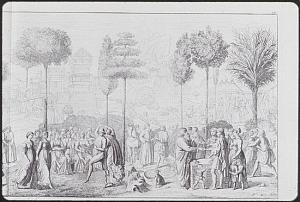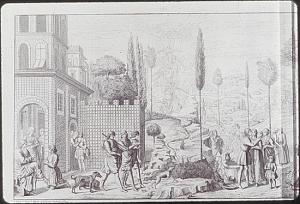
Nozze di Giacobbe di Rachele (detail)
Carlo Lasinio
1828
Physical Description
Technique: engraving
Production Description
Production Date: 1828
Provenance
Current Location: private collection
Reproductions
-

Lasinio, Pitture a fresco del Campo Santo , 5. -

Lasinio, Pitture a fresco del Campo Santo , 6.
Electronic Archive Edition: 1
File Name:
op82.rap.xml
Scholarly Commentary
Introduction
Carlo Lasinio's Pitture a fresco del Campo Santo di Pisa displays a series of engravings from fifteenth–century paintings attributed to Giotto, Memmi, Gozzoli, and other early Italian masters.
Production History
Lasinio's work was quite successful. It originated in an 1806 prospectus for publication, an 1812 first printing, another printing in 1822, and a second edition in 1832-3 with re-engraved plates.
Autobiographical
DGR at some point acquired a copy of the 1828 edition of Lasinio's work. In his Memoir of his brother's life, WMR quotes Holman Hunt as follows: “The companionship of Rossetti and myself [in 1848] soon brought about a meeting with Millais, at whose house one night we found a book of engravings of the frescoes in the Campo Santo at Pisa.”. This book proved the catalyst for the founding of The Pre-Raphaelite Brotherhood. As WMR went on to point out, the engravings were important to the three young men for giving “some idea of the motives, feeling, and treatment, of the paintings of Gozzoli, and of those ascribed to Orcagna and other mediæval masters. It seems that Rossetti was not quite prepared beforehand to believe in these very olden painters, and Brown specially cautioned him not to undervalue them. I well recollect the enthusiasm with which, subsequently to seeing the engravings, Dante spoke to me on the subject.”
Bibliography